Solway Cockle Fishery Management Study
A report summarising the trial of management options in the Scottish Solway cockle fishery
10. Annex
Annex 1: Information on Shellfish Classification
Background
1. Bivalve shellfish, which includes cockles, mussels and oysters, are filter feeders. They feed on phytoplankton but they can also accumulate microbiological and viral pathogens as well as naturally occurring toxins at levels which can cause illness in humans if found in sufficient quantities.
2. Because of this, all shellfish harvesters must comply with the food safety requirements set out in legislation [8] . This includes the requirement to ensure that the bacteriological and toxin health standards are met before the product is sold, and that product must be sold via a premises that the local authority has approved for that purpose. In addition full traceability throughout the supply chain is essential and it is the food businesses' responsibility to ensure that those requirements are met.
3. The Food Standards Agency in Scotland (FSAS) is responsible for the classification and monitoring of all shellfish production areas in Scotland and those requirements are also set out in food hygiene legislation [9] . These requirements mean that regular shellfish samples from classified areas must be submitted for analysis on a routine basis. These samples must be taken at a frequency and location specified by the FSA, overseen by authorised Shellfish Sampling Officers (SSOs) using the agreed protocol. [10] Further details on how this applies to the Solway for the duration of the study can be found below.
4. Local authorities are responsible for enforcing food law. This means that if anyone harvests, handles or processes shellfish in a manner other than that set out in food law, the shellfish can be seized, destroyed and the responsible person prosecuted by the local authority concerned.
Solway Management Study - Initial Classification
5. The classification area for the purposes of the management study is the area which is permitted to be fished by Scottish Government. It will in effect cover the areas which remain subject to The Inshore Fishing (Prohibition of Fishing for Cockles) (Solway Firth) (Scotland) Order 2011. For the purposes of the management study only, the initial classification award for the area fished will be 'B'. Under food hygiene legislation this means that all cockles fished from the area must be dispatched for depuration or cooking. They cannot be sold to the open (unapproved) market (either in the UK or abroad) without this treatment taking place first.
6. It is intended that for the duration of the study, pre depurated weekly samples identified with the appropriate grid reference will be collected from DeeFish Ltd in Kirkcudbright, by authorised SSOs. 2 samples will be required - one for microbiological analysis (this is used for classification purposes) and the other for toxin analysis per week. The specified amounts and the packing and dispatch requirements can be found in the sampling protocol. The classification and toxin health standards for shellfish are set out in law (summarised below).
Ongoing E. coli monitoring and classification
7. See Annex 1. If any classification sample is found to be out with the initial 'B' classification up to 46,000 E. coli per kg shellfish flesh, then the classification will immediately be downgraded to 'C' by FSAS. This will require to be reflected in all documents accompanying the shellfish from the premises. 2 samples at least a week apart at either 'A' or 'B' would be required before the classification will be re-established at 'B'.
8. Under no circumstances for the duration of the study will the area be considered 'A' class.
9. Any result >46,000 E. coli per kg shellfish flesh will mean that harvesting is suspended until 2 results below that level are found at least a week apart.
Toxin monitoring
10. See Annex 2. Any breach of the toxin limits will mean that all harvesting must cease until 2 samples can be collected at least 48 hours apart from the area being harvested.
Product found over the regulatory limit
11. Given that samples from the premises may be used not only as official control samples but also as end product samples by the harvester/processor then the harvester/processor must act on any results above any of the limits set out in law. In effect any shellfish found in breach of the health standards for either E. coli or toxins need to be destroyed. Liaison with the local authority environmental health department should take place immediately if that is found to be the case.
12. Please contact FSAS if you wish to receive shellfish results directly. Otherwise information can be received by your local authority.
Classification
Live bivalve molluscs ( LBMs) shellfish harvesting areas are classified by monitoring the levels of E. coli in shellfish flesh. Treatment processes are specified according to the classification status of the area.
In all cases, the health standards in Annex III of EC Regulations 853/2004 and the microbiological criteria adopted under EC Regulation 2073/2005 must be met.
| Live bivalve molluscs ( LBMs) shellfishharvesting area classification |
||
|---|---|---|
| Category |
Result (Per 100g Flesh) |
Action |
| A |
<230 E.Coli/100g of flesh |
May go directly for human consumption if end product standard met. |
| B |
<4,600 E.Coli/100g of flesh |
Must be subject to purification, relaying in Class A area (to meet Category A requirements) or cooked by an approved method. |
| C |
<46,000 E.Coli/100g of flesh |
Must be subject to relaying for a period of at least 2 months or cooked by an approved method. |
| D | >46,000 E.Coli/100g of flesh |
Prohibited. Harvesting not permitted. |
Biotoxin limits:
The maximum permitted levels of biotoxins in shellfish are as follows:
Paralytic Shellfish Poisoning ( PSP): 800 micrograms/kilogram
Amnesic Shellfish Poisoning ( ASP): 20 milligrams/kilogram
Lipophilic toxins (tested by LC-MS):
i. OA/DTXs/PTXs: 160 micrograms of okadaic acid equivalents/kilogram
ii. YTXs: 3.75 milligram of yessotoxin equivalent/kilogram
iii. AZAs: 160 micrograms of azaspiracid equivalents/kilogram
Diarrhetic Shellfish Poisoning ( DSP) (for species not tested by LC-MS): DSP toxins must not be present
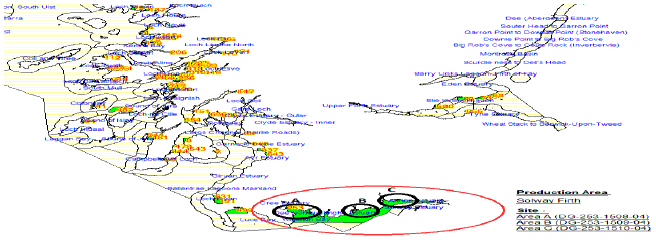
Annex 2: Beach-based Daily Harvest Sheet
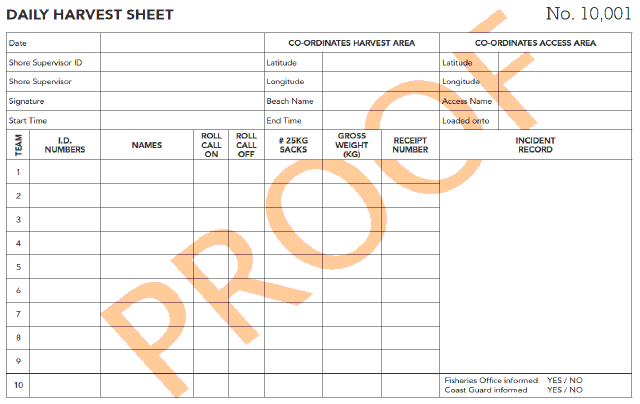
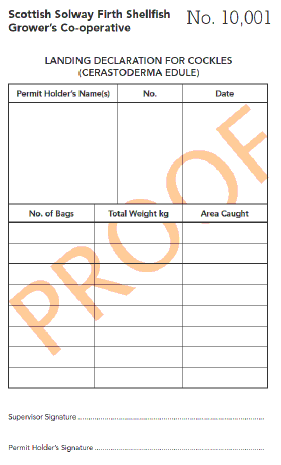
Annex 4: Beach to Distribution Centre Movement Sheet
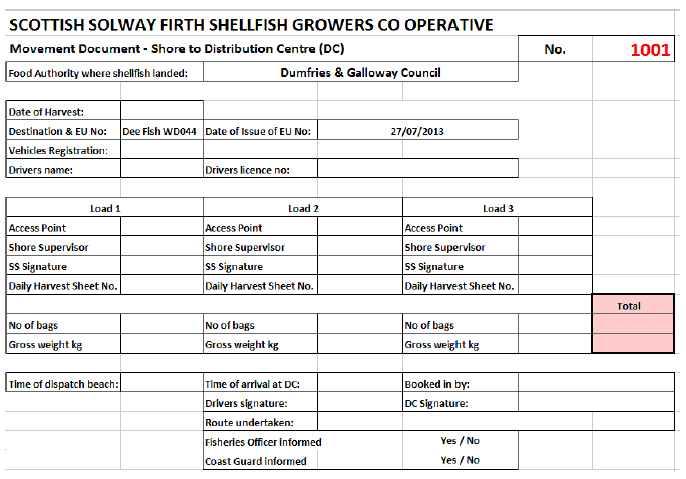
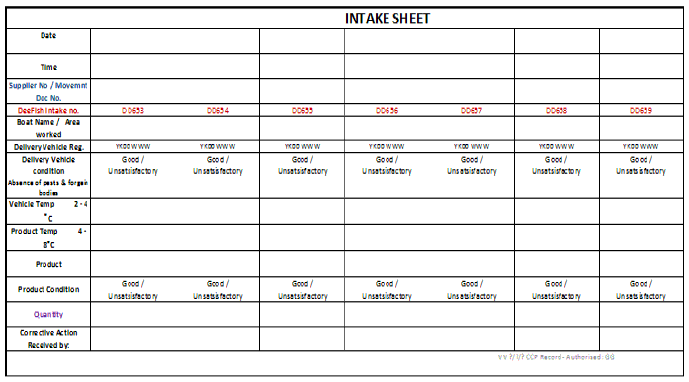
Annex 6: Publications Surrounding the Management Study
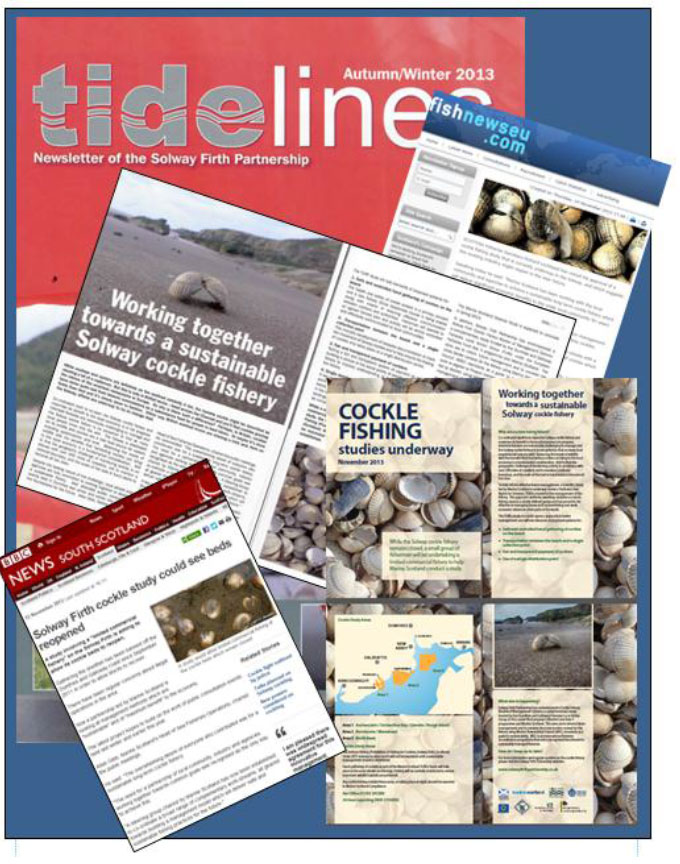
Annex 7: Number of picking licences at mean picking rate.
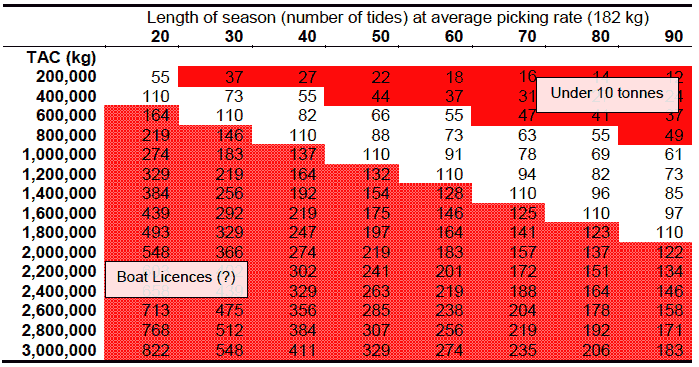
Annex 8: In Practice: TURFs from around the World
TURF systems in operation today have originated through two processes. In Japan and various western Pacific Island communities, TURFs have evolved from long-standing customary practices dating back to the 16th century that have gradually become formalised into law. Conversely, the adoption of TURFs in Chile and Galicia, Spain represented a top-down process and a desire for innovation and improvement in management systems following biological decline and overexploitation. In terms of institutions and design the TURF systems in Chile and Galicia are of particular relevance to the Solway as the TURF concept was used as an innovative tool to deal with the problems of effort controls and the presence of open-access conditions. Older TURFs in Japan and the Pacific have proved valuable in informing internal management mechanisms.
Chile: TURFs were introduced as a co-management measure in Chile in response to a crisis surrounding the management of the economically value species known locally as 'loco' ( Concholepas concholepas), a small-scale dive fishery target this species of abalone. Following an initial crisis in the 1980s and the subsequent failure of command-and-control measures, from 1991 a new law created spatial TURF units known as Management and Exploitation Areas of Benthic Resources ( MEAs).
In 1993, when the fishery was opened, divers with historical rights in the fishery were granted licences. The loco fishery was divided into 12 Units of Fisheries, each one having a regional TAC, which was then subdivided by the number of divers. Licences were only granted to registered and recognised fishing associations as opposed to individuals, with the allocation granted at a federal level. It is the responsibility of the association to develop a management plan at their own expense, which is then approved federally. It is the responsibility of the MEAs to conduct annual stock assessment and file harvesting plans. In addition, a rental fee based upon the size of the MEA is paid in order to cover the costs of federal oversight.
In Chile, the managerial responsibility was devolved to local organisations as while the project had specific biological objectives; it also had strong socio-economic objectives. The artisan sector in Chile is important, providing 87% of the employment in the industry in 1992 (Bernal et.al 1999). The local associations are issued the MEAs for an undefined time period, and the organisations are constrained by a TAC and technical and conservation guidelines that are set at a federal level. The Chilean loco TURF system represented a completely closed system, as the only legal way to gain access to the fishery is through participation within the MEA project.
In terms of internal management measures, practices vary across the MEAs. In some, effort is allocated and assigned to specific areas in order to optimise the exploitation of space within the TURF. Others adopt rotating harvest zone policies, and other pool harvests and revenue to avoid economic waste and issues of inequity. Most MEAs organise with buyers to operate a short period of harvesting, this allowed revenues to be maximized as effort is concentrated when prices are at their highest. As the loco fishery is characterised by numerous small production units spread over the coast, the harvest is coordinated between the various production units so that the total harvest is distributed evenly over the marketing period.
There is a broad tendency to see the whole Chilean system as a success. The Chilean MEA system has acquired worldwide attention, and it has been reported that catch per unit of effort is higher, the mean size of individual locos are higher, and prices received are higher under the MEA system. Moreover, it is reported that the operational costs of the fleet are must less within the MEA than in the historical fishing grounds (Castilla et al. 1997). However, due to the initial success of the loco TURF system, the management framework was intensely promoted by the government and quickly applied to other benthic resources. This process occurred with little concern for the natural variability of the different species and has led to a series of socio-economic problems along the coastline. For instance, TURFs were created for species that naturally migrated along the coastlines with harvesting practices mirroring the coastal migration. As the internal management of the TURFs did not account for the natural migration of the stocks or the fishers, TURFS have been abandoned and serve socio-economic problems remain.
Japan: Japanese TURFs developed in an ad-hoc manner in an attempt to protect areas resources from outside poachers. In Japan, the TURF boundaries are generally associated with historical or municipality boundaries, which encompass fishing villages. Exclusive access to the resources within 5 km of the shoreline is awarded through Japanese Law which grants access rights and responsibility directly to Fishery Cooperative Association ( FCAs). The FCAs are administrative bodies who manage a particular TURF, with government providing the scientific advice and overseeing regulations. There are 1300 FCAs in Japan which are responsible for a large number of species including complex multi-species TURFS using a wide array of gear types. Each FCA has an individually developed administrative structure and operations that govern the management of each fishery. Japanese FCAs have far reaching responsibilities, including providing credit to fishermen, provision of landing and handling facilities, marketing and the purchasing of inputs.
Within the FCAs, sub-organisation of Fishery Management Organisations ( FMOs) carry out all the decisions on a local basis. The FMOs represent a group of fishermen, usually pursing a particular species or using a specific gear. Scientists set the TAC, and the prefecture government licences the participants through a limited entry scheme. It is then the responsibility of the fisheries cooperative - the FMOs - to determine the actual details of management. Examples of practice in this micro-management system include: rotation systems that spread effort over space and ensure equal access to hotspots; and use of restrictions on gear and effort in each area. Many TURFS in Japan operate harvest and revenue pooling arrangements in order to install a sense of fairness and minimalize conflict and risk for fishers in each area of the TURF. The pool is then redistributed on a pre-arranged basis.
Galicia, Spain: As within Japan and Chile, TURFs in Galicia in Spain (also located in Cantabria and Andalucía) have evolved from historical practices and the allocation of fishing areas to users is based upon long-standing relationships between specific artisanal communities and their coastal waters (Boan et al. 2012). In 1993, the regional government created community-based fishing licences and divided the Galician coastline into 9 fishing areas. Spanish TURFS, such as those for the goose barnacle in Galicia, award exclusive access to fishing territories to Cofradias, compulsory organisations that represent fishing areas, with eligibility based upon the historical presence of the Cofradia in the given area. The intention behind the Spanish TURFs was a response to biological crisis in some stocks, but also an attempt to protect inshore fishing interests by awarding the Cofradias exclusive access up to 5 nautical miles from the coast, thus protecting them from competing with larger, offshore vessels.
Each Cofraria submits an annual plan for the resources its aims to exploit, which is evaluated by fisheries biologist within the Fisheries Authority. In Galicia, where the Confrarias have scarce financial resources, one or two people often design the annual management plans. The annual plan details the internal management of the stocks by authorising a set number of fishers, it allocates the areas to be fished, sets economic and production targets, carries out stock assessment, designated the number of working days and sets individual daily quotas (Molares and Freier 2003). The Confrarias are also responsible for the financial programming of the TURF and the marketing of the product. Occasionally, monthly or annual rotations are employed in order to allow areas to repopulate (Bosan et al. 2003). Each unit also has its own surveillance system, while poaching is guarded against in conjunction with national authorities. The Galician TURF for the barnacle fishery has been highlighted as ushering in significant beneficial changes in terms of fisheries management in the area (Molares and Freier 2003).
Malta: In Malta, a TURF system was introduced in order to control fishing effort on the highly migratory dolphin fish. The rights are allocated via a lottery and award the user with the exclusive right to fish for dolphin fish in the 11 maritime districts in which there are 130 fishing sites. There is a seasonal fishery as capture is only permitted between August and December, and sales are highly regulated, as all landings must be sold through regulate commercial channels in the wholesale market. Length of tenure lasts for one year.
Annex 9: Overview of Current Cockle Management Programmes in the UK
The River Dee Estuary: The River Dee cockle fishery is located in an estuary between North Wales and the Wirral. The fishery has five main cockle beds that vary spatially according to spatfall, exploitation and other external factors. Before the implantation of a regulation order (Dee Estuary Cockle Fishery Order 2008), the beds were periodically closed between 1997-2005 as the open-access nature of the fishery had created a 'boom and bust' operation. Now, the fishery is management in line with a short-term objective of annual stock monitoring and the setting of the annual TAC, with the long-term objective to create a sustainable fishery providing regular income. Due to the implementation of a successful management plan, in 2011 the fishery is said to have added £2.5 million to the local economy and in 2012 the Marine Stewardship Council certified the Dee estuary.
Since 2001, a TAC has been implemented, with access to the fishery permitted through a licence. However, as the number of licences was not restricted, in the intermittent years in which the fishery was opened, the length of the season decreased from 34 days in 2001, to 7 days in 2002, 16 days in 2003 and 3 days in 2005. In order to combat the economic problems experienced within the fishery (continued rent dissipation and seasonal shortening), a management plan placed strict controls on entry. A licence is required to fish for cockles in the fishery and the management plan sets a limit on the total number of licences to be distributed, with the cap set at 50. The maximum annual exploitation rate (the TAC) is then sub-divided between the license holders to create individual quotas. The IQs are allocated on a daily basis, based on an established number of fishing days. Typically, the daily quota has been set at 300 kg.
Eligibility of licence holders:
- Licences issued on a point systems
- Applicants must have a track record in the commercial cockle fishery on the Dee estuary - licences were allocated on the basis of experience of active and material participation in the commercial fishery.
- Apprenticeship scheme: A maximum of 3 apprenticeships are awarded annually to enable new entrants to participate in the fishery.
- Allocations are unable to legally favour locals.
Other regulations:
- Size limits: A 'take-able' cockle is defined as having a square opening of 20mm measures across each side. Cockles of this length are in their second years of growth.
- Gear restrictions: The fishing method is restricted to hand-gathering only, with a rake head not exceeding 30 cm in width.
- Time restrictions: annual season is closed from 1st Jan to 30th June. No fishing on a Sunday or one hour after sunset and one hour before sunrise.
Monitoring and enforcement:
- Daily landings declarations are required when beds are open. Details required are: date, beds from which cockle were taken, weight harvested and buyer details. Failure to complete valid landings declarations within the specified time period results in immediate suspension from the fishery.
- Landings are made directly from the fishery in pre-approved Environmental Agency Wales sacks. Along with the identifiable sacks, referencing of sales notes and daily landings records are used to make sure there is no addition of cockle from outside the estuary during transportation to grading yards.
- Illegal cockling prosecuted and licence holders issued with formal caution - warning letters and suspensions.
- Overnight surveillance operations put in place, including the use of helicopters with heat sensors to identify illegal activity.
Thames estuary: The Thames Estuary Cockle Fishery Order was established in 1994 in response to heavy pressure on the fishery in the early 1990s created by increased pressure and technology-induced efficiency within the fishery, notablythe replacement of hand gathering by continuous delivery hydraulic dredging of cockles.
In order to produce a sustainable fishery, a series of byelaws were created which limit certain inputs and output and access is granted through a permit. As dredges exploit the fishery, the fishery focuses upon limiting effort through controlling: maximum vessel size, engine power and dredge size. As this form of exploitation is more believed to be more destructive than hand-picking, a maximum damage rate is imposed to ensure that cockles are not damaged during harvesting. This is often referred to as a 'smash rate'.
While there are imposed limits to fishing times and upon the quantities that are landed (no info on how allocated between vessels), only 14 vessels are licensed to fish for cockles within the area. Monitoring of the harvest takes place through a requirement that skippers must return catch data showing: area fished, quantity taken and time spent fishing. Licences are issued at a cost of £1,000 per annum.
The Wash: The Wash cockle management plan lays emphasis on stakeholder involvement in order to promote co-management of the fishery amongst the local fishing industry. In terms of regulation, the Local Authorities have created and enforced byelaws that regulate access and effort. The main management measures for this fishery are:
Biological controls:
- The fishery will not be opened unless there is a minimum spawning stock biomass (3,000 tonnes of adult cockle of >14mm) is identified in surveys.
- A TAC (of up to 33.3% of the total adult stock) is set.
- Selection of areas: Beds containing a significant proportion of juvenile stocks will not be opened. Cockle beds must contain 70% adult stocks to be open.
Effort controls:
- Licence limitation: A licence grants access to the fishery and a maximum of 68 licences are awarded.
- Holders of entitlements may also have to purchase a dredging or handwork licence.
- This quota is sub-divided into separated allocations for the dredging and handwork sectors. Allocations alter according to stock and socio-economic conditions - no information on criteria for allocation.
- Daily vessel quota: a maximum of four tonnes of cockles per dredging vessel taken per day.
- Time closures: The dredged fishery is limited to 4 days a week from an opening date; the handwork fishery is open 7 days a week.
- A fishing vessel may target only one fishery in one calendar day.
Additional controls:
- Minimum sizes: No minimal size is defined but only adults (approx. 19-21 mm in length with a minimum width of 14 mm) can be harvested.
- All fishing gear must be approved by governing Joint Committee
- Smash rate limit - no more than 10% (by weight) may be smashed during dredging operations.
- Gear restrictions: hydraulic suctions head inside opening must not exceed 76 cm, no vessel may deploy more than one dredge, no vessel over 14 m.
Monitoring and enforcement:
- Fishery Officer conduct quayside inspections of landings.
- Licence holders must provide catch returns on a weekly basis.
Dundalk Bay: The cockle fishery in Dundalk Bay was closed in 2006 and 2007 to allow the Irish Sea Fisheries Board to implement a management plan following a period of intense fishing activity that led to overexploitation. Initially, the management plan did not limit entry into the fishery. While access was restricted through the use of a licensing system, no limit was put on the number of vessels allowed to operate. This led to the economic viability of the cockle fishery being put at risk. A permit system, with eligibility awarded through track-record, with a set number of 33 permits issued has been put in place for 2011-16.
Biological objectives are met through the implantation of a TAC, a minimum landing size of 17 mm, and fishing activity will only be allowed in areas where cockle density is greater than 4 per square meter. The fishery is also regulated by additional management measures in order to promote economic viability. The TAC is allocated between the vessels, with a daily IQ set at 1 tonne per vessel per day. However, in order to avoid rent dissipation if the allocation falls before 250 kg per vessel, the fishery is closed. Gear restrictions set a maximum dredge blade width of 0.75 for suction dredges and 1.0 m for non-suction derides.
Bury Inlet: The Burry Inlet is a large estuarine complex located between the Gower Peninsula and Llanelli in South Wales. The cockle fishery is managed by a series of byelaws that attempt to limit and manage effort.
Regulations:
- Access is regulated through a licence, and a fixed level of effort is determined by a limited number of licences.
- TAC is allocated amongst users through a daily individual quota. This can vary depending on stock levels, but was typically established at 100 kg but between 2013-14 increased to 300 kg.
- No harvesting on a Sunday and a minimum landing size implemented.
- Closed areas: The cockle beds are managed in a flexible spatial approach. Individual beds can be closed for a variety of reasons to account of different growth rates of cockles on different beds.
Monitoring and enforcement:
- Control of vehicles is used to reduce unregulated access to beds by removing the means of transport for illegally gathered cockles.
Ribble Estuary: In August 2012, the cockling bed in the Ribble Estuary between Lytham and Southport was re-opened after a period of closure following 26 incidents of the coastguard being called out to rescue poorly equipped and unlicensed boats in a two month period. The North West Inshore Fisheries Conservation Authority ( NWIFCA) issued commercial permits for cockling under strict new regulations. The new measures restricted cockle fishing to one tide per day from Monday to Thursday only, require that boats that travel to and from the bed must have qualified skippers and specify that all cockles must be sold direct to the merchants on the bed and landed at Preston docks.
A restricted fishery in the Foulnaze Bank in the outer Ribble Estuary in August 2012 was successful. The beds were opened for 5 weeks in July-August, for 4 days per week (Mon-Thurs). It yielded the permitted Total Allowable Catch ( TAC) of 800 tonnes in 9 days without incident. Between 130 and 180 permit holders fished each day.
Aside from the licensing and TAC restrictions, other regulations included:
- A £500 charge for the permit.
- Applicants using boat had to complete the recommended safety training and carry recommended safety equipment.
- All cockles must be transported from the beds using registered fishing vessels and landed at Preston marina.
- All boats must have safety equipment and all boat skippers are required to have the necessary qualifications to operate a boat in darkness.
Belfast Lough: A pilot cockle fishery was initiated in Belfast Lough in 2008. Under this, the fishery was operated by two small under 12 m vessels, one which operated a suction dredge and the other a standard cockle dredge. In 2009, 13 vessels were in operation, each given a seasonal quota of 8 tonnes and each vessel was designated with two specific days of operation between the 5th and 23rd October in which they could fish. This ensured that only two vessel were fishing at any given time. In 2010-12, no fishery took place due to a lack of recruitment.
Dutch Cockle Fishery: This hand-raked cockle fishery is located in the Dutch North Sea coastal region of the Wadden Sea and Oosterschelde. There are 31 licences for the fishery and the members of the Dutch Organisation of Cockle Fishermen catch between 400 and 700 tonnes (shelled cockle meat) annually. The fishery is only deemed economically viable if there are 600-800 cockle per square meter, a licence is required and a closed season is set, with fishing taking place between 1 July and 1 September.
Contact
There is a problem
Thanks for your feedback